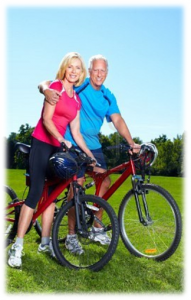 Exercises
Exercises
Three types of exercises that are recommended for patients with knee osteoarthritis: flexibility, resistance and cardiovascular flexibility exercises. All three are very good for easing stiff joints which will help patients with their ADLs. It is recommended that the stretches be done in the morning. It may be easiest to perform them in warm bath water which eases the joint stiffness.
Resistance exercises are important to build the muscles around the arthritic joints. By building muscle it helps to absorb the shock and protect the joint from further injury. There are 2 types of resistance exercises: isometric and isotonic. Isometric are typically the most easy resistance exercise for the OA patient. The strengthening occurs with contraction of the different leg muscles without moving the joint.
Cardiovascular exercise uses big groups of muscles. The best recommendation for cardio fitness in the arthritic knee patient is water aerobics or cycling. The National Arthritis Foundation is a great resource for exercise DVD’s. A referral to the local physical therapist can also be helpful. I find my patients like the personal instruction and the P.T. also helps to maintain their technique.
 Braces
Braces
Slip on Knee Brace: Osteoarthritic patients like the compression and warmth from a slip on knee brace. Biomechanically id does not improving loading pressures but the patients state that their knees feel better with the brace. Another excellent non-surgical option for patients with knee OA is a custom unloader knee brace. The principle behind the brace is that it will transfer the weight bearing axis of the body to the “good “side of the knee and unweight the arthritic side. The patients that are candidates most have either a medial or lateral compartment of the knee that still has some cartilage present. If the OA is in both the medial and lateral compartment the brace will not work. The brace is worn for physical activity and the patient must have a leg that will support a brace.
 Ortho Biologics
Ortho Biologics
-PRP:( platelet enriched plasma. ) This is currently one of the hottest topics in orthopaedics. PRP is being studied and used in the treatment of an array of orthopaedic diagnosis ranging from plantar fasciitis to OA. It isproduced by drawing blood from the patient peripherally. The next step is the centrifuge the blood to separate the plasma from the platelets. It is then injected into the injury site. A recent article in the American Journal of Sports Medicine noted that PRP decreases NFkB which is a major enzyme in the pathway of the formation of osteoarthritis.
– Autologous cartilage implantation: this type of transplantation takes either donorarticular cartilage cells or the patient’s cartilage. This will get transplanted in the arthritic area of the knee. A recent article in the Journal of Bone and Joint Surgery, noted that long term follow up data of 7 to 10 years is revealing good to excellent results.
– Bone Marrow stimulation: this is a surgical procedure where multiple drill holes are placed into the area of arthritis in the knee and then the body’s stem cells invade that region producing fibrocartilage which is a scar tissue like cartilage. This type of transplantation has decreased results over time whereas the autologous transplantation has better longevity.
Injections
-Hyaluronic acid injections: HA is a naturally occurring fluid in a healthy knee. As the knee becomes arthritic the molecular weight of the hyaluronic acid decreases and the composition changes to the fluid.Replacement of the hyaluronic acid by injection into the arthritic knee has been proven to reduce symptoms for up to a year…
-Cortisone: there are a lot of myths regarding cortisone injections.I explain to my patients cortisone is like a strong Motrin that is placed into the knee where the symptoms are present. It typically will quickly “shutdown” the inflammatory response. I discuss that it will not slow the progression of the disease but will reduce the painful symptoms. It is a low risk injection and most patients are very pleased.

Leave a Reply
You must be logged in to post a comment.